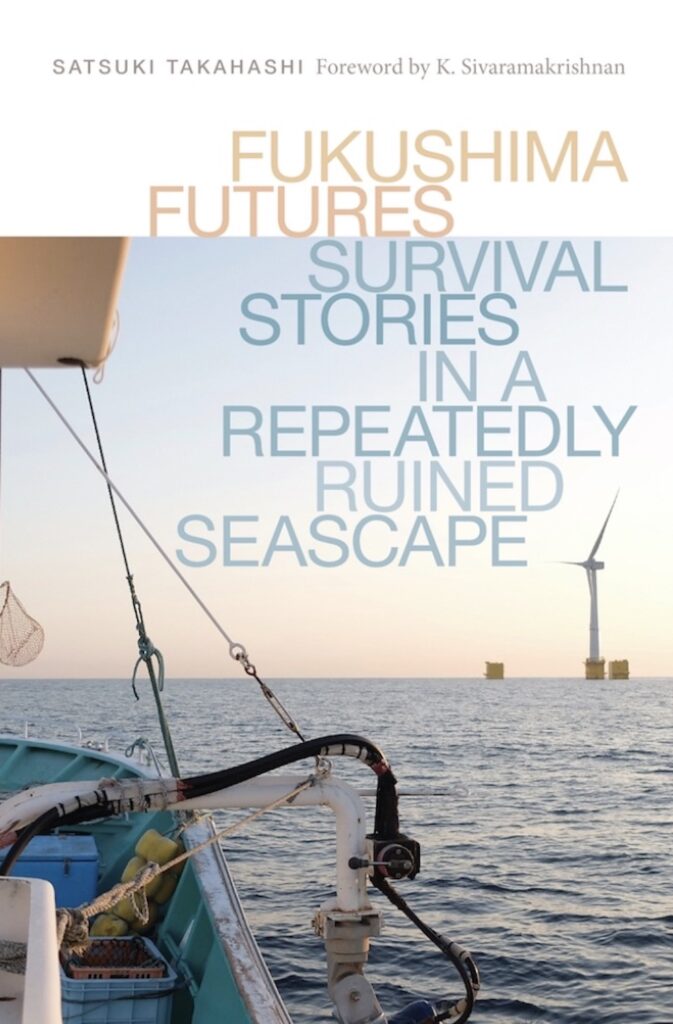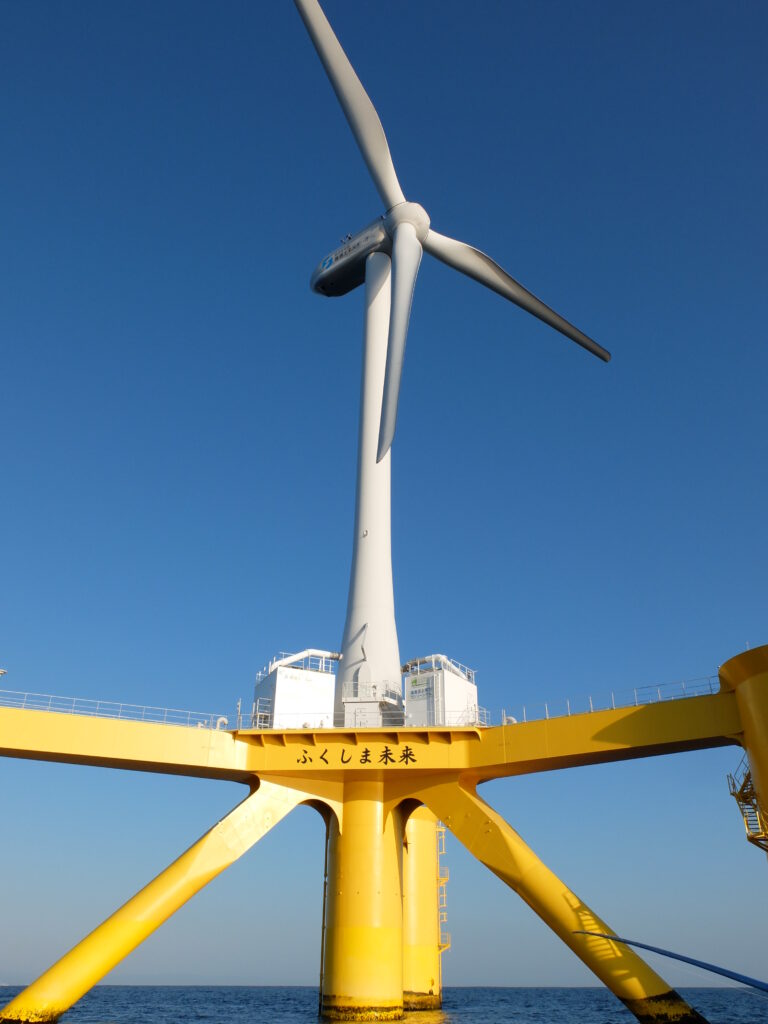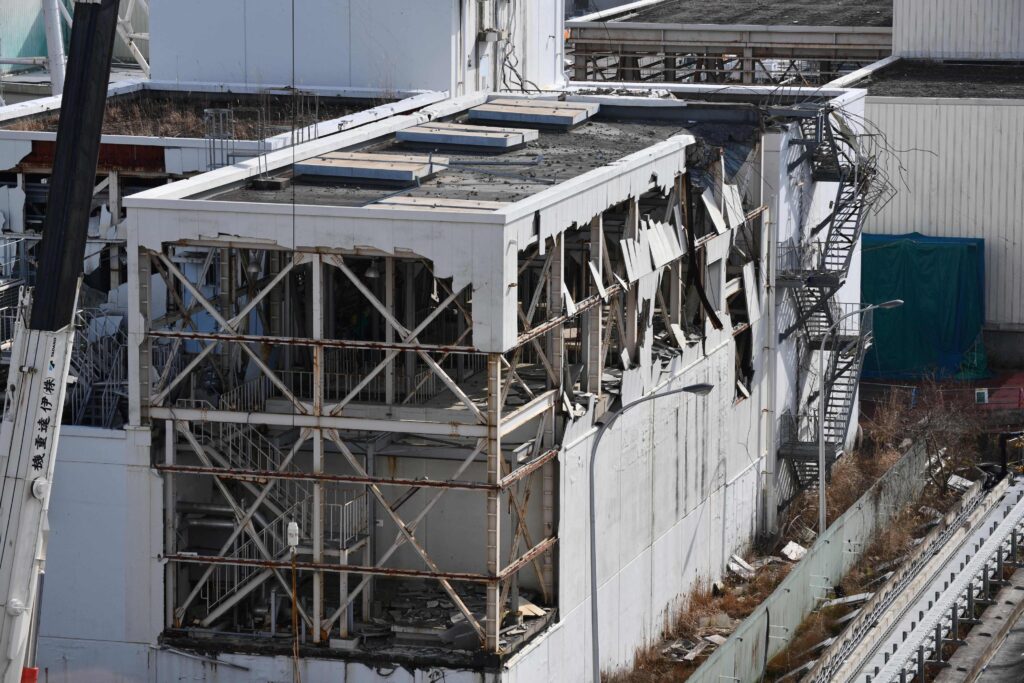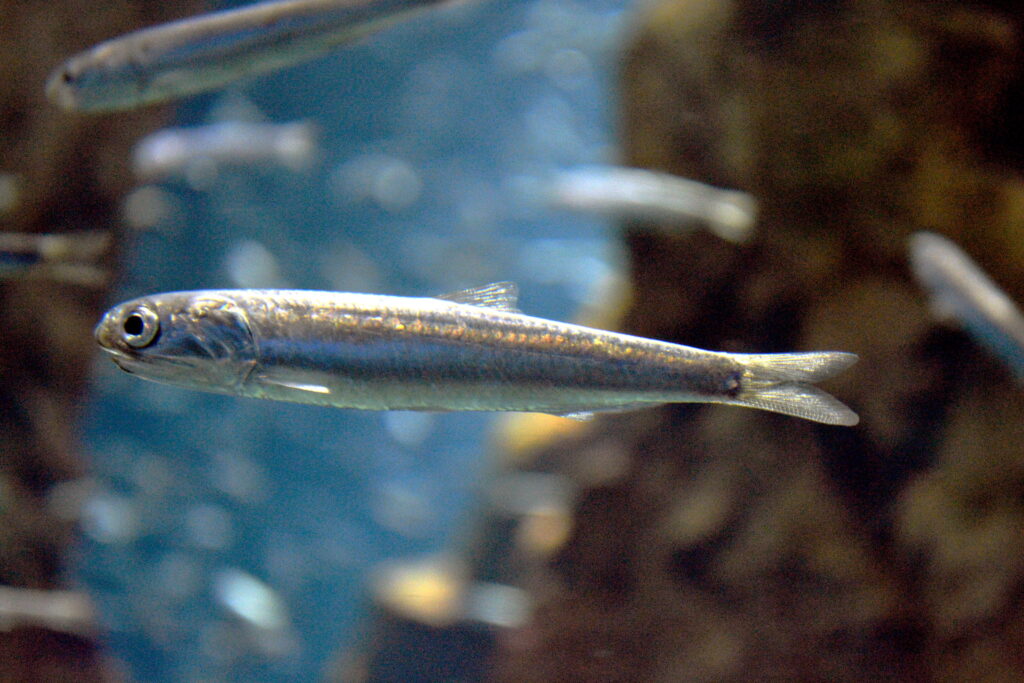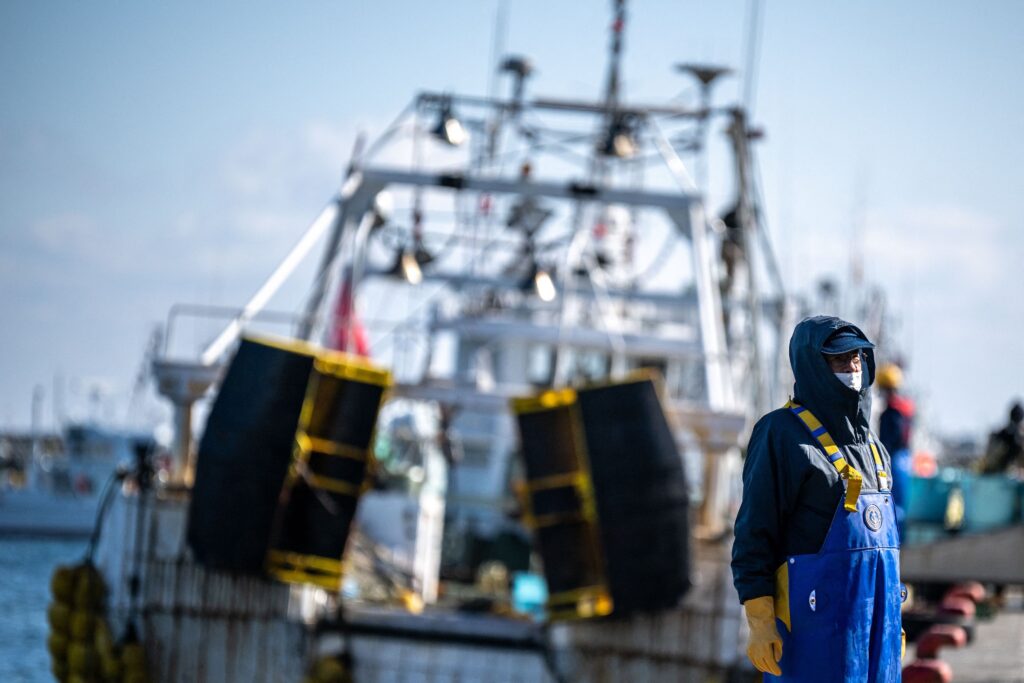The Persistence of Fukushima’s Fisherfolk
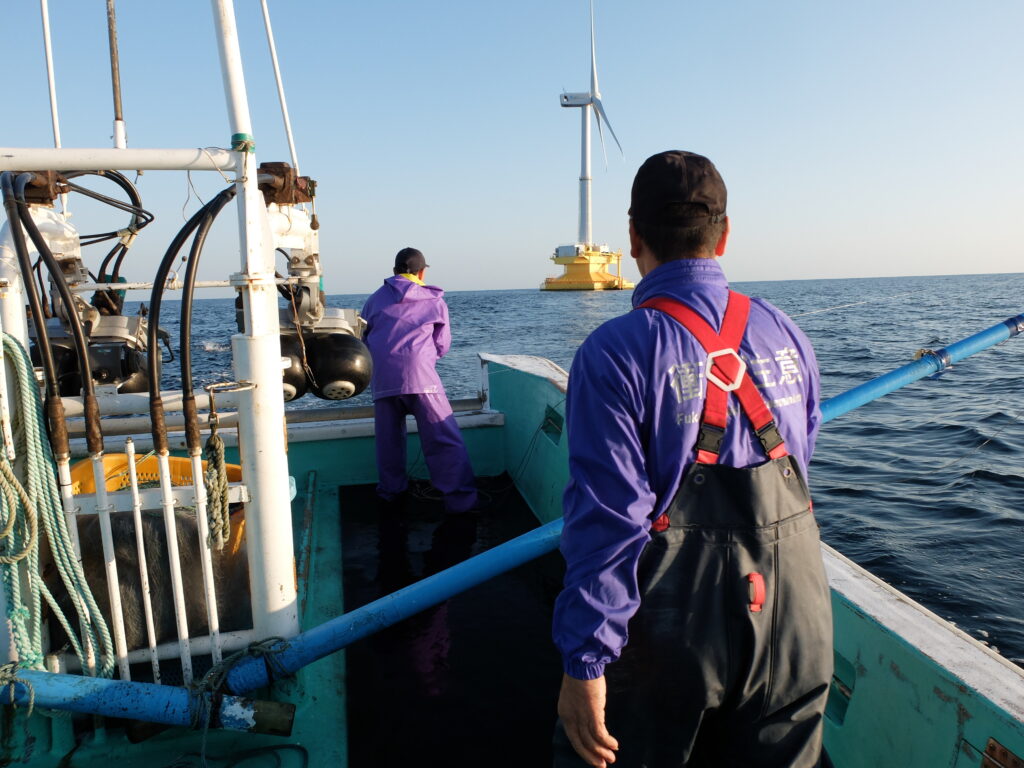
Excerpted from Fukushima Futures: Survival Stories in a Repeatedly Ruined Seascape by Satsuki Takahashi. University of Washington Press, 2023. All rights reserved.
In March 2011, a massive earthquake and tsunami triggered a catastrophic nuclear meltdown at Tokyo Electric Power Company’s (TEPCO) Fukushima Daiichi Nuclear Power Plant, sending radioactive wastewater into the ocean off Japan’s northeast coastline. The Joban Sea suddenly became known as one of the most contaminated seascapes on the planet. Coastal fisherfolk were banned from making a living off the abundant marine resources they’d depended on for generations.
Almost immediately, Japanese officials started coming up with recovery plans to support the commercial fishing industry and reduce the country’s dependence on nuclear power. They set their sights on renewable energy, with the ambitious plan of creating the world’s first floating wind energy farm. The excerpt that follows takes readers to a day in 2017 when anthropologist Satsuki Takahashi accompanied fishermen on a research trip to several offshore wind turbines installed for a pilot project. Located just outside the 20-kilometer evacuation zone surrounding the wrecked nuclear power plant, the turbines were meant to represent hope for a new, technological future—but the project wasn’t exactly going as planned.
The offshore wind farm project eventually stalled when the government withdrew their support after a series of technical glitches. Meanwhile, 12 years after the disaster, the commercial fishing industry has reopened. Radioactive cesium levels of fish caught in Fukushima prefecture have mostly been reduced to pre-disaster levels (with some exceptions), and most countries have lifted import restrictions on fish caught in Fukushima. But the effects of the nuclear crisis still linger as decommissioning work at the plant continues. TEPCO, despite concerns from Fukushima residents, has announced plans to release more contaminated wastewater into the sea this summer—throwing the future of commercial fishing in the region into question yet again.
—SAPIENS Editorial Team
At 4:20 a.m. on an autumn day in October 2017, the sky in Fukushima was still dark and full of stars. The wind was calm and so was the sea. As soon as I got out of a rental car, I tapped my cellphone screen to call Mr. Yajima (a pseudonym), a fisherman I knew through my fieldwork on fisheries in the area. He told me to just enter the fishing dock, and I would find his boat with no problem.
Sure enough, it did not take much time to spot the only boat with a running engine. Within the quiet wharf, the noise of Mr. Yajima’s fishing boat sounded especially loud. His boat was a typical small-scale coastal fishing vessel slightly under five tons, common on the coast of Fukushima and neighboring prefectures. Mr. Yajima and his two fellow fishermen, in addition to an observer from a private maritime research firm, were already set for the voyage.
Less than a year after the 2011 nuclear meltdown in Fukushima, the Japanese government had announced the creation of a public-private consortium, Fukushima FORWARD, for building the world’s first floating wind farm off the nearby coast. The consortium leaders proudly claimed that their project would open a new future for not only Fukushima and Japan but also for the nation’s fishing industry. In June 2013, the consortium had introduced the public to their first floating windmill, named “Fukushima Future” (Fukushima Mirai).
Today Mr. Yajima had invited me out on the boat to see the floating wind farm—three windmills and a substation—in action for the first time. The morning’s fishing trip was part of a special mission requested by the Fukushima FORWARD consortium, with the goal of collecting data to find out whether the floating wind turbines could in fact perform as “artificial reefs” and increase the density of wild fish habitat. These were possibilities suggested by existing studies on offshore wind farms. The observer’s role that morning was to gather data on fish habitat around three turbines of the floating wind farm. Mr. Yajima and his fellow fishermen’s role was to catch fish for data collection.
When the boat went out of the wharf, Mr. Yajima picked up speed, and louder engine noise filled the captain’s booth. As he was moving his boat forward, he constantly checked the screens of his fish-finder and GPS plotter while looking through the front and side windows and occasionally chatting with friends through his two-way radio. I quietly observed his moves and the screens of various fish-finding devices.
After about an hour, I caught sight of a skinny pole-like object sticking out of the ocean ahead on the horizon. “That’s the wind turbine,” Mr. Yajima said, “still far ahead, though.”
Although I had seen images of the turbines in photographs and videos online, the actual structure looked far more enormous than I expected. As we approached the first windmill, it was so mountainous that I had trouble keeping the entire above-water structure in one camera frame.
Mr. Yajima slowed down and idled his boat about 100 meters away. Quickly, the other two fishermen moved to the back of the boat and attached two long poles (or outriggers) on both sides of the boat for trawling. At the same time, the observer from the maritime research firm stuck his head into the captain’s booth and jotted down on his clipboard the temperature and depth of the water that Mr. Yajima read on his GPS screen. Mr. Yajima then confirmed that all the gears were set, and he started trawling for fish.
In the middle of turbine-hopping, Mr. Yajima pointed his finger at a building on the coast and told me that it was the crippled Fukushima Daiichi Nuclear Power Plant. In fact, standing 20 kilometers offshore, we could see a complete view of Fukushima’s long shoreline. For a couple of minutes, everybody quietly looked at the coastline.
I wondered what the others were thinking while looking at the crippled plant, but I struggled to come up with an appropriate way to ask so that I would not sound inconsiderate. “What a panoramic view,” I said eventually.
“Yes,” responded Mr. Yajima. He said nothing further.
Then the observer abruptly said, “One of my colleagues designed the marine hatchery that used to exist next to the [ruined] nuclear power plant,” adding, “but it’s all washed away except for the rooftop.”
I told him that I had been to the hatchery myself back in 2004. “They used the thermal discharge from the nuclear power plant, didn’t they?” I asked. The observer seemed a little surprised and responded evasively.
Mr. Yajima then returned to his captain’s booth, and the boat started moving to the next windmill.
Before the disaster, the Fukushima Fish Nursery Laboratory had been a cutting-edge facility where marine biologists bred fish juveniles of more than 80 species in their hatcheries to support sustainable fishing. When I visited in 2004, I was acting as a translator for fisheries experts from around the world who were in Japan for a global conference. A young ichthyologist who worked for the hatchery had escorted our group through the vast facilities, showing us the stone tanks where they raised abalone, sea urchin, flounders, plankton, and more.
The ichthyologist told us that his laboratory could produce fish juveniles three to four months faster than the natural speed because it used thermal discharge from the neighboring nuclear power plant. According to him, the warmed seawater speeds up not only the spawning cycles but also the growth of fish juveniles. In addition, he emphasized that the method of recycling thermal discharge was an advanced, environmentally conscious technology that turned hazardous wastewater into a useful resource. As I was translating his explanation into English, a few fisheries experts expressed their admiration.
At that time in 2004, none of us expected that the fish hatchery would end up with a famously tragic future. No one even mentioned any risk of a future accident.
Then, on March 11, 2011, the tsunami utterly destroyed not only the nuclear power plant but also the adjacent fish hatchery, washing away the buildings, the tubs, fish, and six staff members.
In the aftermath, the hatchery existed only as a ruin. The only thing that remained on the site was the frame and the rooftop of the stadium-like building, where thousands of flounder juveniles were once nurtured. At sea, the nuclear substances released from the crippled nuclear reactors further damaged the precarious seascape while threatening the future survival of fishing families.
In the end, that morning’s catch was rather unsuccessful. While trawling for two hours, we only got three small dolphinfish and two small bonitos. If we were to sell the catch, the fuel for the trip would cost significantly more than the yield. But since it was part of the wind farm’s research project, the fuel cost was paid by the consortium, and the fish were returned to the ocean after the observer recorded their names, weight, and length. A little later, they got another bonito. Again, it was small. This time, the observer threw the fish back in the water without weighing it and told Mr. Yajima to wrap up the research fishing for that morning.
“Let’s go home then,” Mr. Yajima yelled. “The game is over, let’s call it a day.” The other two fishermen started putting away the fishing gear and cleaning up the deck.
The capricious nature of fishing means that catches are always uncertain, dependent on weather and other oceanographic conditions and luck.
Did the poor catch that morning mean that the floating wind farm, like artificial reefs, had not helped increase wild fish populations, as the consortium originally expected it would do? “We don’t know the answer yet,” the observer responded. “But I am certain that there are fish around the wind farm.” He said that his previous research fishing trip was busy with catching as many as 20 dolphinfish.
The older fisherman said that this morning’s catch was poor because the ocean was too calm. “Trawling is usually successful when a strong wind blows from the north,” he explained. Mr. Yajima and the other fisherman nodded. But the unsuccessful result still seemed to be disappointing for the fishermen, especially for Mr. Yajima.
Nevertheless, or maybe because of that, Mr. Yajima did not give up his search for fish. On the way back to his home port, he adjusted the setting of his fish-finder unit to capture young anchovies (shirasu), who were in season at that time in the early fall. When we got close to his wharf, Mr. Yajima spotted something on the screen and called his friend into his captain’s booth with an animated tone of voice. Tapping on the screen of the fish-finder with his thick index finger, Mr. Yajima told his friend, “This must be a school of anchovy juveniles!”
After we returned to the harbor, Mr. Yajima agreed to let me interview him for a few more minutes. I asked about his concerns with the future of commercial fishing. Up until that point, the government was still providing compensation for those affected by the nuclear disaster, but it would be discontinued once commercial fishing was fully reopened. There was no guarantee that fish prices would ever recover to pre-disaster levels, particularly considering the ongoing nuclear wastewater issue that made consumers wary of buying and consuming fish from Fukushima.
“These days,” Mr. Yajima murmured, “every night when I try to go sleep, I can’t help but think about the future and get overwhelmed by anxiety.”
He said that because of having spent such uneasy nights, he was hoping that he would have a successful outcome during the research fishing trip that morning. If he could catch a lot of fish, he thought that that might reduce his worries. The discouraging result, however, was unlikely to do so.
Before the nuclear accident, an unsuccessful fishing trip like this would have been seen as just another familiar frustrating experience. The capricious nature of fishing means that catches are always uncertain, dependent on weather and other oceanographic conditions and luck. But, for Mr. Yajima, who was living with the ongoing nuclear crisis, even one poor catch was enough to turn his hope about the future into anxiety.
A few minutes into the interview after the research fishing trip, Mr. Yajima stood up and told me that he had to go somewhere.
“Going back to catch the shirasu?” I asked.
“Maybe,” he smiled. He started walking toward his storage unit to get his special fishnet for catching young anchovies.
There was no guarantee that the school of young anchovies would still be there. Nonetheless, for Mr. Yajima, the image of young anchovies on his fish-finder screen was a sign of hope amid acute anxieties. The futures of the floating wind farm, the radioactive ocean, and commercial fishing were all daunting. But the existence of young anchovies was a certainty, even though catching them was at that point a game of chance.
This excerpt has been edited for style, clarity, and length.

































